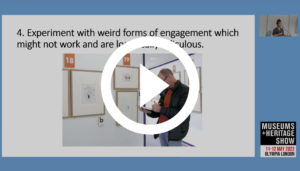Even during the initial phases of exhibition design practicalities and logistics can quash ideas just as they bubble into existence.
Experience is often the source of this defence mechanism; it would be too difficult, too confusing, too out-there.
But putting those fears aside is an approach which has worked particularly well for Emma Stirling-Middleton, Curator at The Cartoon Museum.
Speaking during a session at this year’s Museums + Heritage Show entitled ‘Think big, go small: lessons from creating exhibitions in a small museum’, the central theme was to cast out worry.
The session drew in a crowd with standing room only, and detailed the transition from a career in large national museum level gallery projects and international blockbuster exhibitions to The Cartoon Museum, a relatively small independent museum.
The move was prompted by Stirling-Middletons goal to learn and experiment within a smaller museum and take risks, something not as easy as a “small cog in a big machine”.
At The Cartoon Museum, Stirling-Middleton said there is more freedom to experiment, to better “connect with your visitors, take risks and make decisions quickly without meetings and processes.”
Among the session’s list of learnings – taken during her first months at the museum – is to ‘experiment with weird forms of engagement which might not work and are logistically ridiculous’.
Stirling-Middleton pointed to the Cartoon Museum’s ‘Laughter Lab’ exhibition, which ran until June this year, as an example.
At first glance the exhibition was simply a selection of comedic cartoons displayed on the museum’s walls. But the purpose of the cartoons was to conduct a “mass public psychology experiment” which hoped to explore the psychology behind what makes cartoons funny.
Stirling-Middleton had devised the exhibition in partnership with Robin Dunbar, Professor of Evolutionary Psychology in the Department of Experimental Psychology, University of Oxford.
Together, the exhibition was concocted to allow not only visitors to see 38 cartoons, but – when split into 19 pairs of artworks – to have their say on which was funnier. Clipboard and branded pencil in hand, visitors not only became walking feedback for the exhibition, but a data-point for the scientific research into humour.
The data collected from the visitors, which was collected and logged from pieces of paper, has since been taken by Dunbar and used in the publication of research into humour.
The logistics of a ‘hybrid-exhibition’ such as Laughter Lab might have seemed overwhelming had there been too much consideration from the logistic, said Stirling-Middleton, but in the mindset of experimentation, “we went for it, we took a risk and actually it’s been brilliant”.
The vast majority of people attending the exhibition contributed, the museum reports, and more importantly enjoyed themselves while filling in their responses. They were “talking to each other, having conversations, having arguments because they think that one’s funnier [than the other]”.
Hear the result of the world's first mass public experiment exploring the psychology behind cartoon humour at The Cartoon Museum Late: Laughter Lab
There'll be comedians, drinks and tours!
More info: https://t.co/rnMf1swMUS@HendinArts @RobAuton @HollyBurnComedy @AnnieMcTweet pic.twitter.com/WOQ9ObEkJB— The Cartoon Museum (@Cartoonmuseumuk) April 22, 2022
“If we’d been really risk sensitive and we really thought through all the logistics of doing this – of making sure we had enough paper and ink and transferring all of the data – if we’d really thought it through we would have thought it’s not a great idea”.
During the session, Stirling-Middleton also touched upon other learnings – among them the idea that exhibitions are not products and visitors are not consumers, and that changing an exhibition once open is no bad thing.
The rest of this session is available on-demand via the Museums + Heritage Show website, alongside the rest of this year’s talks.
Watch the Session in full

 To see this talk in full, as well as the rest of the sessions at this year’s Museums + Heritage Show 2022, attendees can login here for free.
To see this talk in full, as well as the rest of the sessions at this year’s Museums + Heritage Show 2022, attendees can login here for free.
Didn’t attend this year’s Museums + Heritage Show? You can still access the recorded sessions via this link.









